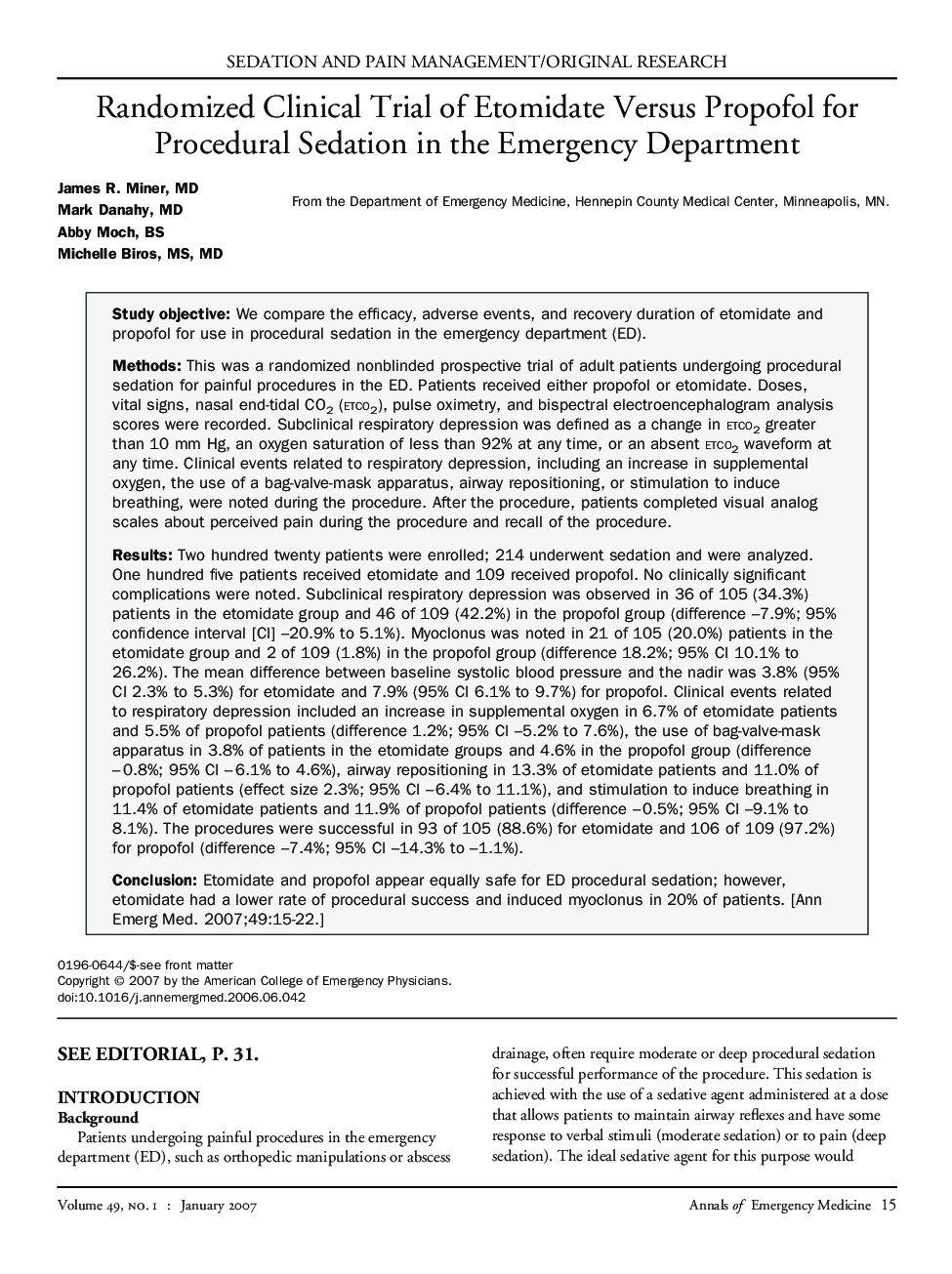| Article ID | Journal | Published Year | Pages | File Type |
|---|---|---|---|---|
| 3234196 | Annals of Emergency Medicine | 2007 | 8 Pages |
Study objectiveWe compare the efficacy, adverse events, and recovery duration of etomidate and propofol for use in procedural sedation in the emergency department (ED).MethodsThis was a randomized nonblinded prospective trial of adult patients undergoing procedural sedation for painful procedures in the ED. Patients received either propofol or etomidate. Doses, vital signs, nasal end-tidal CO2 (etco2), pulse oximetry, and bispectral electroencephalogram analysis scores were recorded. Subclinical respiratory depression was defined as a change in etco2 greater than 10 mm Hg, an oxygen saturation of less than 92% at any time, or an absent etco2 waveform at any time. Clinical events related to respiratory depression, including an increase in supplemental oxygen, the use of a bag-valve-mask apparatus, airway repositioning, or stimulation to induce breathing, were noted during the procedure. After the procedure, patients completed visual analog scales about perceived pain during the procedure and recall of the procedure.ResultsTwo hundred twenty patients were enrolled; 214 underwent sedation and were analyzed. One hundred five patients received etomidate and 109 received propofol. No clinically significant complications were noted. Subclinical respiratory depression was observed in 36 of 105 (34.3%) patients in the etomidate group and 46 of 109 (42.2%) in the propofol group (difference –7.9%; 95% confidence interval [CI] –20.9% to 5.1%). Myoclonus was noted in 21 of 105 (20.0%) patients in the etomidate group and 2 of 109 (1.8%) in the propofol group (difference 18.2%; 95% CI 10.1% to 26.2%). The mean difference between baseline systolic blood pressure and the nadir was 3.8% (95% CI 2.3% to 5.3%) for etomidate and 7.9% (95% CI 6.1% to 9.7%) for propofol. Clinical events related to respiratory depression included an increase in supplemental oxygen in 6.7% of etomidate patients and 5.5% of propofol patients (difference 1.2%; 95% CI –5.2% to 7.6%), the use of bag-valve-mask apparatus in 3.8% of patients in the etomidate groups and 4.6% in the propofol group (difference –0.8%; 95% CI –6.1% to 4.6%), airway repositioning in 13.3% of etomidate patients and 11.0% of propofol patients (effect size 2.3%; 95% CI –6.4% to 11.1%), and stimulation to induce breathing in 11.4% of etomidate patients and 11.9% of propofol patients (difference –0.5%; 95% CI –9.1% to 8.1%). The procedures were successful in 93 of 105 (88.6%) for etomidate and 106 of 109 (97.2%) for propofol (difference –7.4%; 95% CI –14.3% to –1.1%).ConclusionEtomidate and propofol appear equally safe for ED procedural sedation; however, etomidate had a lower rate of procedural success and induced myoclonus in 20% of patients.
